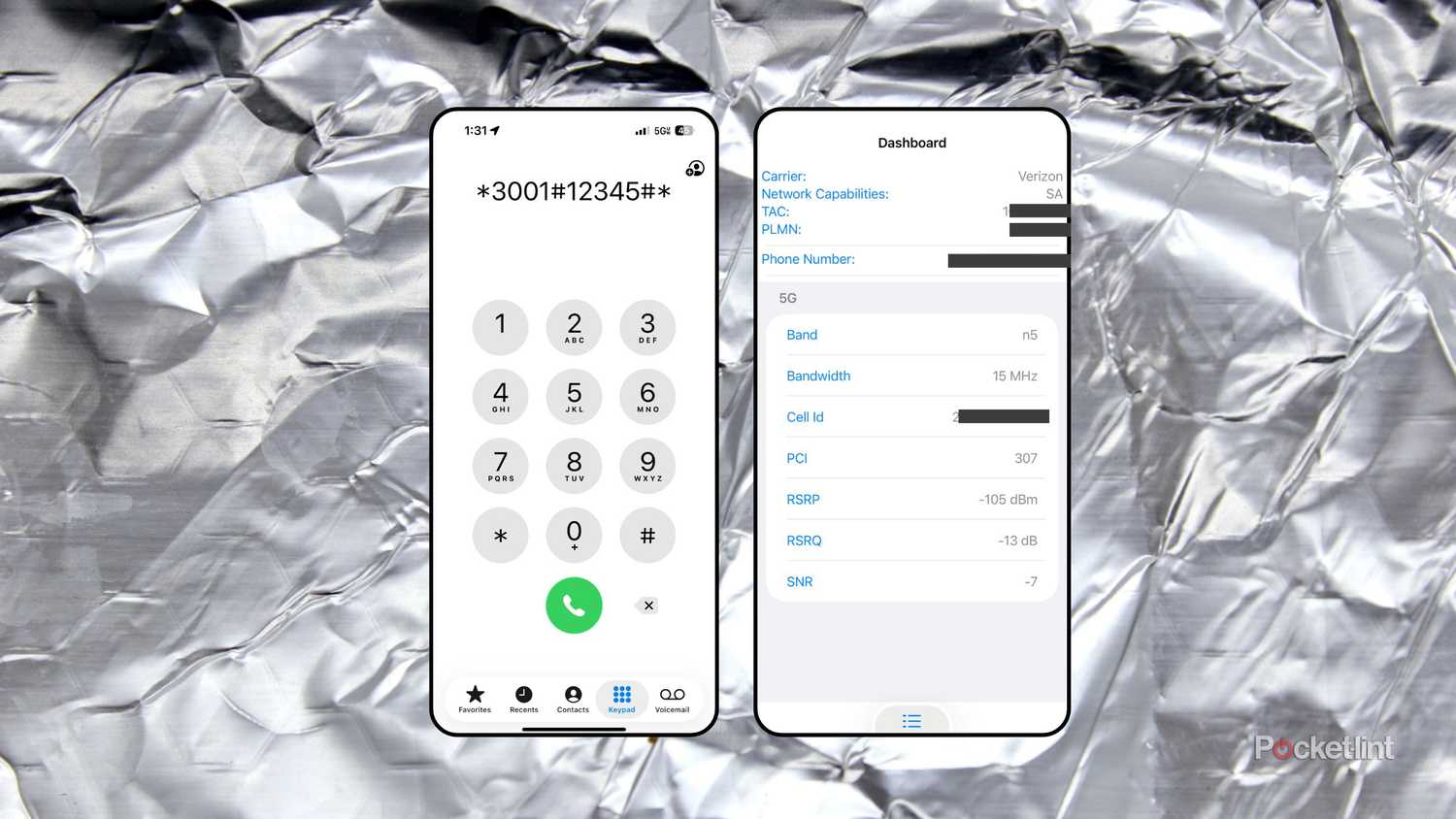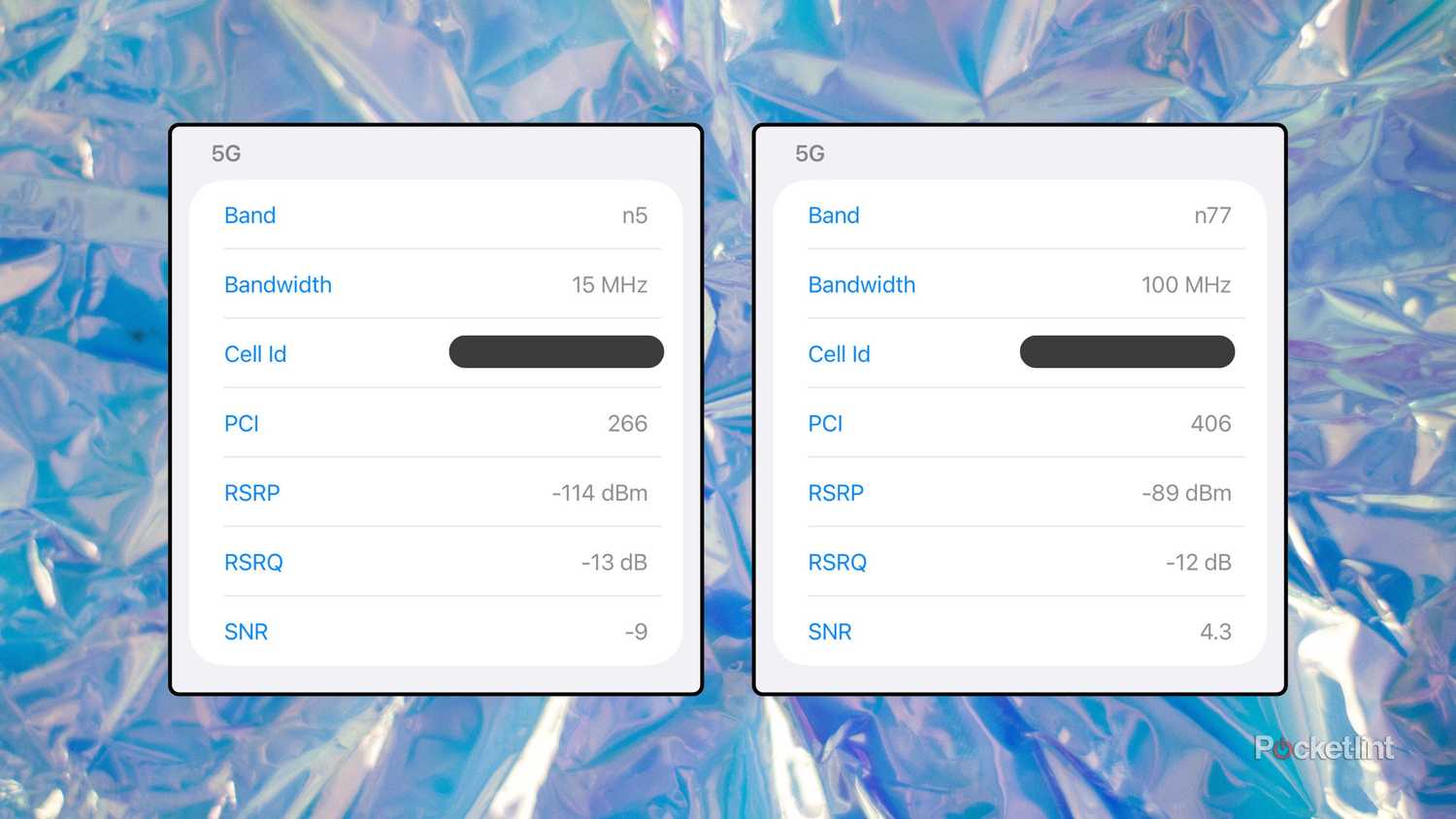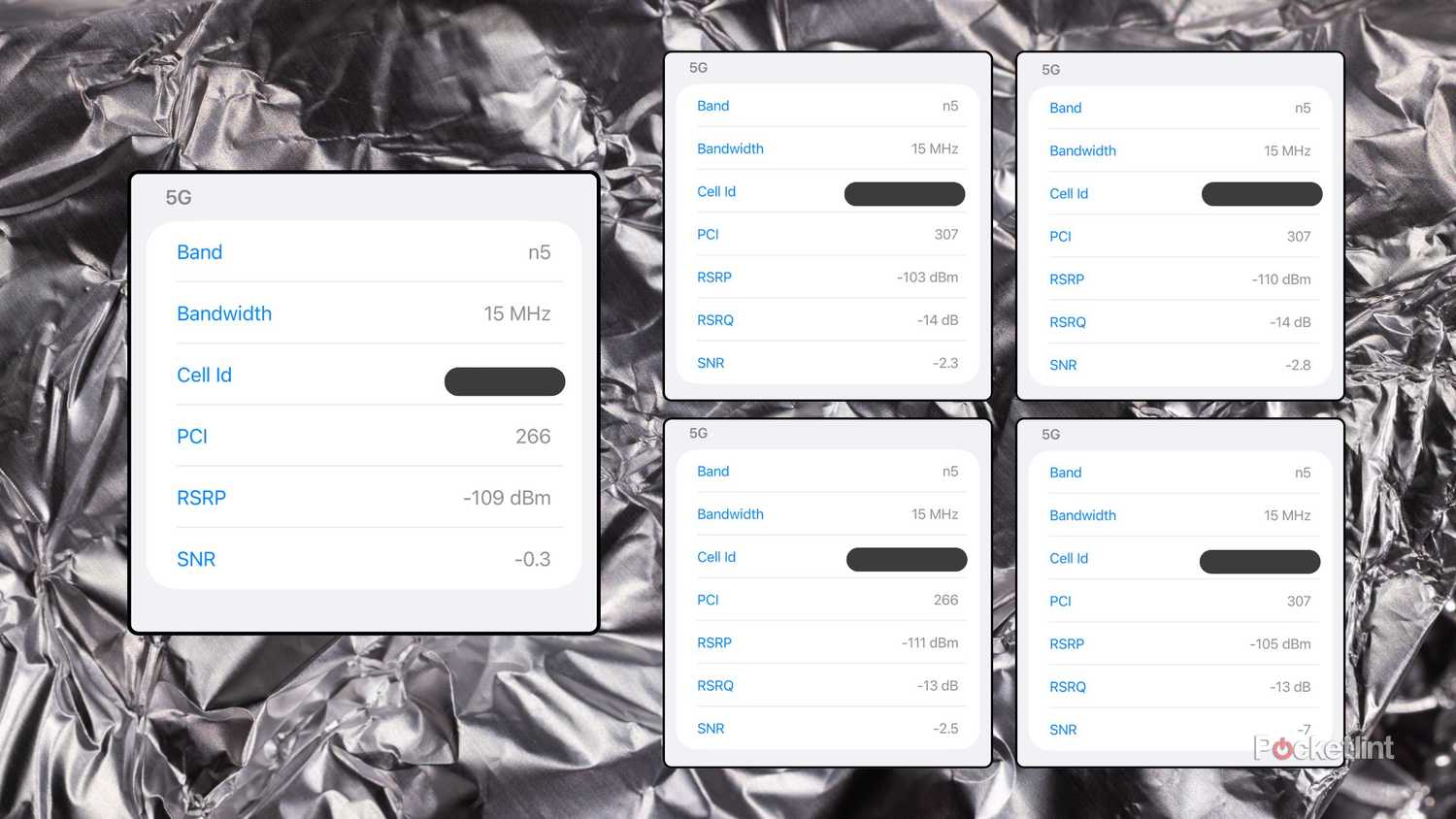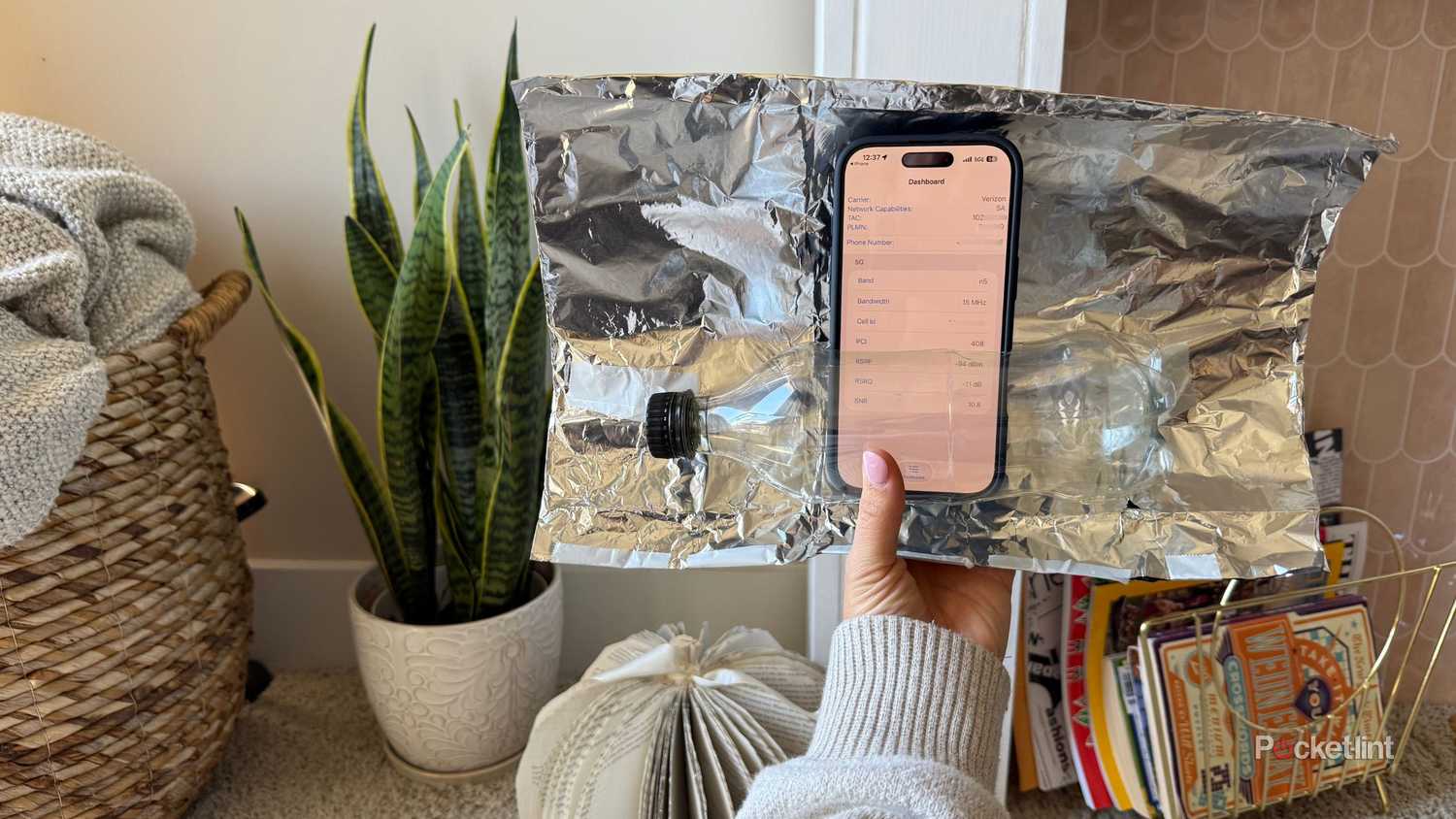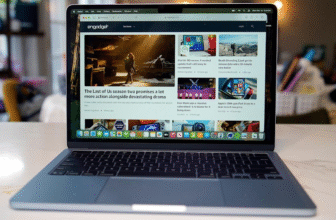You are stranded within the wilderness with just one bar and a textual content that gained’t ship. You additionally occur to have 32 ft of aluminum foil. Why you could have it, I do not know — however you suppose to your self: Might I take advantage of this to spice up my cell sign someway?
I do not know why you had that aluminum foil out within the wilderness both. But it surely’s a stable thought rooted in actual science — a 2017 Dartmouth study proved that aluminum foil or different metallic surfaces can optimize wi-fi indicators. I’ve examined this concept earlier than, first by boosting after which blocking Wi-Fi signals utilizing aluminum foil. This time, it is my iPhone’s flip.
I attempted constructing a cell-signal booster out of aluminum foil, and this is what occurred.
What does aluminum foil must do with sign energy?
The place the thought comes from
After experimenting with aluminum foil to each increase and disrupt my dwelling Wi-Fi sign, I began questioning if it may do the identical for my cellphone. What sparked the thought was a childhood perception that tin-foil hats actually may block undesirable indicators. Whereas I am not a member of that committee, I used to be enthusiastic about Faraday cages — these conductive enclosures used to dam electromagnetic fields. If metallic surfaces can confine indicators, can additionally they management them? Enter the amplification speculation.
Aluminum is very conductive. When an electromagnetic wave hits its floor, free electrons contained in the metallic begin transferring nearly immediately, producing a counter area that cancels the wave contained in the metallic and bounces it again outward. In essence, it displays it or blocks the wave from transferring by way of it.
My DIY amplifier borrowed its form from a satellite tv for pc dish, which collects faint indicators from the area round and focuses them onto a receiver. The curved metallic floor displays incoming radio waves towards a focus, the place they’re amplified. In my experiment, I wished the aluminum parabola to gather the radio waves and focus them in the direction of my cellphone’s antenna.
How I measured my sign energy
With Discipline Take a look at Mode
You may roughly estimate your sign energy by discovering the ascending bars beside your community service (like AT&T or Verizon) and mobile community tech (like LTE or 5G), often on the prime of your cellphone’s display. There’s sometimes solely these 4 “bars” that provide you with a basic thought of how sturdy your sign is. The extra bars, the stronger the sign. If there are not any bars in any respect, nicely, that is whenever you often see somebody strolling round holding their helpless cellphone to the sky in a determined hope to seize some form of connection.
Nonetheless, there is a secret native characteristic on most telephones known as Field Test Mode (or a area check show) that permits you to see a extra detailed breakdown of your community’s data. Whereas there’s quite a lot of acronyms and parameters that the on a regular basis individual may scratch their head at, anybody can entry it by dialing *3001#12345#* into their cellphone app. For the sake of this experiment, I used Discipline Take a look at Mode (on iOS) to see how my sign energy modified in actual time earlier than and after utilizing my home made aluminum foil amplifier.
The parameter I am most fascinated by is RSRP, or Reference Sign Acquired Energy. It is an indicator of sign energy, and also you often need to see it vary from -50 dBm to -120 dBm (decibel milliwatts). The upper the quantity, the stronger your sign — however remember that the numbers are unfavorable, so a sign sitting at -60 dBm is a lot better than one reporting at -102 dBm.
Whereas area check mode can be utilized to precisely measure your cellphone’s sign energy natively, it’s not the identical as a sign energy app or a pace check app, like I’ve utilized in prior experiments to check my Wi-Fi router’s pace.
Now, there’s the matter of your sign high quality, which we are able to see by measuring RSRQ, or Reference Sign Acquired High quality. RSRQ often sits between 0 dB and -20 dB (decibels). Once more, the nearer you might be to zero, the higher the sign high quality. You may also have a look at SINR (Sign-to-Interference-Ratio) because it’s one other good indicator of sign high quality.
Band (the frequency vary getting used) and Bandwidth (how broad the communication channel is) are additionally good indicators we’ll have a look at.
What occurred once I put my iPhone in a home made aluminum foil sign amplifier?
The method and the outcomes
To create the amplifier, I lower the tops and bottoms off three aluminum cans, flattened them out, and taped them collectively. I then lined the sheet with aluminum foil (shiny aspect out) and smoothed it as finest I may. After slicing an iPhone-sized slot into an empty Coca-Cola bottle, I taped each ends to the foil sheet and bent the meeting right into a shallow parabola.
And not using a correct laboratory, it is troublesome to take away all creases and wrinkles from the aluminum foil, which makes this a lower than completely managed experiment. Nonetheless, I am performing it with real-life practicality in thoughts, so it is a check aligned with a real, real-world state of affairs.
Now, I used to be able to carry out the sector check. My community service is Verizon, and I simply occur to sit down smack-dab in the midst of three Verizon cell towers. Fortunately, I’ve a direct line of sight to the one in entrance of my window, which lets me intention my amplifier straight at it for the experiment.
Utilizing the sector check instrument, I positioned part of my house the place my sign energy was persistently the bottom. That is what I measured with and with out my home made amplifier:
With out the amplifier, my cellphone related to an n5 low-band 5G frequency with a slim 15 MHz bandwidth. The RSRP sat at –114 dBm, which is considered very poor. The RSRQ got here in at –13 dB (common high quality), and the SNR at –9 dB, which meant background noise was messing with usable sign.
Now, enter the amplifier. In the identical spot, my cellphone locked onto an n77 mid-band 5G community with a 100 MHz bandwidth. The RSRP improved to –89 dBm — a few 25 dB acquire, pushing it into the “good” vary. The SNR flipped constructive to +4.3 dB, and the RSRQ nudged up barely to –12 dB, which stored it within the common vary.
So, what occurred? Based mostly on concept, the foil did not truly ‘amplify’ my cellphone’s sign. As an alternative, it redirected the prevailing electromagnetic waves within the air in the direction of my cellphone’s antenna. Since I formed the foil in a curved parabolic form (akin to a satellite tv for pc dish), if centered what may’ve been scattered radio waves from that cell tower close by and gave my cellphone the chance to leap as much as a quicker, greater capability band.
My first check labored surprisingly nicely, however I wished to know if the impact would maintain up someplace much less forgiving: the again stairwell of my house constructing. Sadly, I may barely even get a base learn in that spotty spot — my RSRP specifically stored leaping far and wide:
On the left was essentially the most constant base learn I may collect. On the best, I included 4 of essentially the most frequent reads I gathered in that again stairwell. Whereas at first, the aluminum foil appeared to barely enhance the RSRP basically, a slight motion of my fingers threw that consequence out of whack. It was troublesome for me to search out the angle that labored there, and after a couple of minutes I grew annoyed. Whereas it labored up in my house (with a transparent view of the cell tower, as nicely), it wasn’t doing squat in a spot the place I truly wrestle to get a sign in actual time.
I am not about to hold that contraption down 5 flights on daily basis, however the frustration was actual — and in an precise emergency, it might be worse.
It is an ideal instance of how the atmosphere issues in an experiment like this. Stairwells are a sign nightmare — manufactured from concrete, metal, metallic rails, and so on. The radio waves there have been already in all probability an echo chamber of indicators, and my amplifier in all probability solely added to the chaos and created extra reflections than have been there earlier than.
In a really perfect atmosphere (like my house unit), my DIY amplifier can work properly. However in something however, it places a highlight on how finicky and fragile the experiment is.
So, is aluminum foil a sensible sign booster?
No, it is not
If I discover myself on a barren desert street with nothing however a tumbleweed and two bars, this setup may get me the sign to summon Triple-A. So long as my aluminum is completely unwrinkled, there aren’t conflicting indicators, and I have already got a stable likelihood of a textual content going by way of all by itself.
Aluminum foil does not make extra sign. Relatively, it simply tells present waves the place to go. Whereas it will probably work in excellent circumstances, it is fragile, unpredictable, and ridiculously simple to misalign — which may truly even harm your sign reasonably than enhance it. It undoubtedly is not a long-term repair to continuously nagging sign woes, both.
When you’re on the lookout for a real sign booster, I might advocate an official device and even simply transferring to a greater location — even sending that textual content close to a window may enhance your probabilities of getting one or two extra bars basically.
Trending Merchandise

SAMSUNG FT45 Sequence 24-Inch FHD 1...

ASUS RT-AX1800S Dual Band WiFi 6 Ex...


